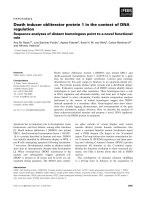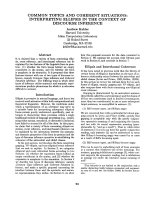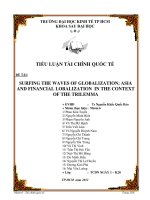Infrastructure in the context of finance crisis. Experiences from ACECC member countries potx
Bạn đang xem bản rút gọn của tài liệu. Xem và tải ngay bản đầy đủ của tài liệu tại đây (735.03 KB, 27 trang )
“Infrastructure in the context of finance crisis.
Experiences from ACECC member countries.”
Report from Japan
At the International Round Table Meeting at Hanoi City, Vietnam
on April 19
th
, 2009
Yukihiko Sumiyoshi, Dr.Eng.
JSCE Representative to ACECC
President, Central Consultant Inc.
Report from Japan
“Infrastructure in the context of finance crisis.
Experiences from ACECC member countries.”
1.The Influence to Japanese Economy by
the Subprime Loan Problem
2.Tne Influence to Construction and Real
Estate Industries
3.The Countermeasure Policy of the
Government of Japan
4.Conclusion
1. The Influence to Japanese Economy
by the Subprime Loan Problem
1-1 Influence to the Japanese Financial System
1-2 Influence to Exporting Enterprises and GDP Development
1-3 Increase of Unemployed
1-4 The Policy Expected to the Recovery of Japanese Economy
1-1 Influence to the Japanese Financial System
The Japanese financial system was recovered and strengthened from the situation
damaged in so called “Lost 10 years” of Japanese economy -1990~2000.
Therefore influence by the subprime loan problem and Lehman bros. shock to the
Japanese financial system is found not so serious.
Total Amount and Ratio of Bad Loans of Banks of Japan
Ratio of Bad Loans by Banks type
(unit : %)
Total Amount of Bad Loans for whole Banks
(Unit : Trillion Yen)
Local Bank
Bank Total
Main Bank
1-2(1) Influence to Exporting Enterprises
Sudden decrease of demand for industrial good (vehicle, electric product, machinery
etc.) happened in global base.
Monthly rate of number of sold vehicles by countries
Quarterly rate of number of sold vehicles by Maker
Japan
China
Russia
U.S.A.
EU
India
Brasil
2007
Jul.
Sep.Aug.
Oct. Dec.Nov.
2008
Jan. Feb. Mar. Apr. May. Jun.
Jul.
Aug. Sep.
Oct.
Renault
Ford
Nissan
VW Gr.
Honda
Toyota
Hyundai
Fiat Gr.
GM
PSA Gr.
2008.Jan Mar. 2008.Apr jun. 2008.Jul Sep.
Subprime Loan Problem
Lehman shock
Lehman shock
1-2(2) Influence to Exporting Enterprises
Japanese Yen value increased against to other countries currency alter subprime
loan problem and Lehman bros. shock.
Average for 5 weeks
Average for 25 weeks
Transition of rate of exchange
‘07
‘08 ‘09
Subprime Loan Problem
Lehman shock
(Unit : yen/us doller)
1-2(3) Influence to Exporting Enterprises
The performance of Japanese exporting enterprises became sharp decline because
of sudden fall of global demand and value up of Japanese currency.
Amount of Sales and Profits by year : Toyota Motors Corp.
Amount of Profit (unit : Trillion Yen)
(予測)
Amount of Sales (unit : Trillion Yen)
Amount of Sales
Amount of Profit
1-2(4) Influence to GDP Development.
Japanese economy which is mainly relying upon her exportation is getting bigger
damages than U.S.A. and EU countries.
Transition of Rate of Real GDP Development
Japan
U.S.A.
EU
‘05
‘06 ‘07 ‘08
Subprime Loan Problem
Lehman shock
1-3 Increase of Unemployed
In Japan unemployed are increasing just after Lehman Bros. shock and active
opening rate on beginning of 2009 is approaching to the level on 2002 which was the
worst level in “Lost 10 years” of Japanese economy
2008・2009年の求人・求職者の推移
0
20
40
60
80
100
120
140
160
180
200
220
240
260
280
300
'97
'98
'99
'00
'01
'02
'03
'04
'05
'06
'07
'08
'08 Jan.
'08 Feb.
'08 Mar.
'08 Apr.
'08 May.
'08 Jun.
'08 Jul.
'08 Aug.
'08 Sep.
'08 Oct.
'08 Nov.
'08 Dec.
'09 Jan.
0.0
0.1
0.2
0.3
0.4
0.5
0.6
0.7
0.8
0.9
1.0
1.1
1.2
1.3
1.4
1.5
1.6
(Unit : 10,000)
Active opening rate
Monthly active job applicant
Monthly number of post
(倍)
Number of Active Job applicant and post
Active Opening rate
Status of Job Applicant, Post and Active Opening Rate on 1997~2009
Lehman shock
1-4 The Policy Expected to the Recovery of
Japanese Economy
Recovery and development of global economy is
considered to be necessary rather long terms.
Therefore the urgent policy to stimulate the recovery of
Japanese economy is expected to plan and implement
early as possible in the issues shown below.
Enlargement of Domestic Demand
Increase of Employment
Development of Regional Economy
2.Tne Influence to Construction and Real
Estate Industries by the Subprime Loan
Problem
2-1 Transition of Construction Investment
2-2 Employment Effect of Public Investment
2-3 Influence to Housing Market
2-4 Influence to Private Non-Housing Construction
Investment
2-5 Increase of Bankruptcy
2-6 Influence to Construction Material Demand
2-1 Transition of Construction Investment
Construction
Investment
49.4 trillion yen
(▲41.2% for peak)
Governmental
Investment
16.6 trillion yen
(▲52.8% for peak)
Number of Labor
Force
537 ten thousand
workes
(▲21.6% for peak)
Amount of Investment (unit : Trillion Yen)
(unit : 10,000 Workers)
Construction industry is supporting the development of regional economy and
employment as one of the trunk industry of Japan, but is recently facing the decrease
of construction investment , especially big decrease of governmental investment.
Governmental Investment
‘76
‘80
‘85 ‘90 ‘95 ‘00 ‘05 ‘08
Private Investment
Number of Labor Force
2-2 Employment Effect of Public Investment
The employment effect of Public Investment is biggest than other types of investment
136person/1 billion yen
(person / billion yen)
1980
1990
2000
Private consumption
Private investiment Public investment
Export
comparison of employment effect by type of investment
2-3 Influence to Housing Market
500,000
600,000
700,000
800,000
900,000
1,000,000
1,100,000
1,200,000
1,300,000
1,400,000
'01 '02 '03 '04 '05 '06 '07 4月 5月 6月 7月 8月 9月 10月 11月 12月 1月
‘08
(yearly base alter seasonal adjustment)
The fall of number of house built on 2007 was a result of the revision of Japanese Building Code.
The number of house built increased from the beginning on 2008, but is decreasing after October
because of cooling of housing market by Lehman shock.
Number of house built (unit : house)
‘08
Lehman shock
2-4 Influence to Private Non-Housing Construction Investment
Private Non-Housing Construction Investment is sharply decreasing after the end of 2008 in
reflection of lack of intension to invest for buildings, factories and facilities by private enterprises.
% (Quarterly, rate of one year before)
→ Anticipated
2006
2007
2008
2009
Total of Nominal
Private Non-Housing
Nominal Private (Building)
Nominal Private
(Civil Work)
Real Private
Company facilities
Subprime Loan Problem
Lehman shock
2-5 Increase of Bankruptcy for both Market of
Construction and Real Estate.
0
50
100
150
200
250
300
350
400
450
500
0
7.0
4
0
7.05
0
7.06
0
7.
07
0
7.08
0
7.09
07.10
07.11
0
7
.12
0
8.01
08.02
0
8
.03
0
8.
04
0
8.0
5
08.06
0
8
.07
0
8.
08
0
8.0
9
0
8.10
0
8.11
0
8.1
2
0
9.01
0
9.02
0
100,000
200,000
300,000
400,000
500,000
600,000
Number(Constraction) Number(real estate) dept(constraction) dept(real estate)
Bankruptcy of Asabu
Tatemono Corp.
(Dept 564 billion yen)
Increase of bankruptcy debt means increate of major bankruptcy
cases at both market of construction and real estate.
(件)
Total Amount of Debt(billion yen)
Number of Bankruptcy companies
Bankruptcy of Urban
Corp.
(Dept 256 billion yen)
Subprime Loan Problem
Lehman shock
debt
debt
500
400
300
200
100
2-6 Influence to Construction Material Demand
0%
20%
40%
60%
80%
100%
120%
9
7
9
8
99
0
0
0
1
02
0
3
04
0
5
0
6
07
0
8.
0
4
0
8.
0
5
08
.
06
0
8.
0
7
08.08
0
8.
0
9
0
8.
1
0
08.11
0
8.
1
2
Cement Ready Mixed Concrete Wood Steel Asphalt
Demand of main construction materials continues to decrease in reflection
of fall of construction investment.
Steel which kept rather stable level of demand by strong demand of
overseas is showing sharp decline after Lehman Bbros. Shock.
Subprime Loan Problem
Lehman shock
3. The Countermeasure Policy of the
Government of Japan
3-1 2
nd
Supplementary Budget for ’08 year
Budget and ’09 year Budget (Approved)
3-2 Supplementary Budget for ’09 year
Budget (Be approved shortly)
3-3 Typical Infrastructure Project targeted by
the Budget
3-1 2nd Supplementary Budget for ’08 year Budget
and ’09 year Budget (Approved)
In view of situation of the Japanese economy after
the Lehman Bros. shock, Japanese government
planned the Second Supplementary Budget for ’08
year Budge and ’09 year Budget. Two Budgets
passed through the Diet on January and March,
2009 respectively.
Major items of the policy for the recovery of the
Japanese economy in two Budgets are as follows.
3-1(1) Support for people’s lives
3-1(2) Support for medium-sized and small companies
3-1(3) Activation of regional economy
3-1(1) Support for people's lives
Fixed Amount Special Benefits for personel
(12,000 yen/person, Youth and Senior 20,000
yen/person)
Labor Insurance Adoption for Irregular Workers
Tax Reduction for Housing Loan
Tax Reduction for Purchasing Eco-Car
2 trillion yen
170 billion yen
340 billion yen
210 billion yen
3-1(2) Support for medium-sized and
small companies
Enlargement of Certification and Loan Limit
Supplement to Limit of Public Fund Injection to
Banks
Tax Reduction for Investment to Promote to
Save-Energy Facilities
Tax Rate Decrease for Medium-Sized and
Small Companies
30 trillion yen
10 trillion yen
190 billion yen
240 billion yen
3-1(3) Activation of Regional Economy.
Reserve Fund for Urgent Economic Affairs
Reduction of Expressway Toll
1 trillion yen
500 billion yen
3-2 Supplementary Budget for ’09 year
Budget (Be approved shortly)
Japanese Government decided the frame of
Supplementary Budget for 2009 Year Budget as a
countermeasure for economic risk of Japan today.
The Budget will be proposed at the Diet for approval
end of April.
The frame of the Budget are as follows
Financial Expenditure 15.4 Trillion yen
(about 2.7% of GDP)
Total Investment 56.8 Trillion yen
Creation of new employment max.2 million jobs for 3 yeas
Comprehensive policy inducing employment , environment ,
welfare , energy , tax system and infrastructure
For Employment
Enlargement of Vocational Training , and Support for
Employment Creation
For Financial Risk
Enlargement of Limit for Purchasing Stocks of Private
Enterprises by Public Finance
For Environment , Energy
Development of Photovoltaic power Generation ,
School New Deal Project
For Medical , Care , Children
For Infrastructure Development , Agriculture and
Fishery
3-2(1) Urgent Countermeasure
2.5 Trillions
41.8 Trillions
3-2(2) Development Strategy
2.2 Trillions
2.8 Trillions
3.8 Trillions
3-2(3) Realization of Safer and Vital
Lives
For Social Security , Consumers affairs
For Support for Regional Government
Tax Reduction for Gift Tax
3-2(4) Revision of Tax System
2.2 Trillions
2.4 Trillions
100 Billions









